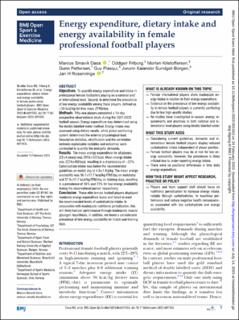| dc.contributor.author | Friborg, Oddgeir | |
| dc.contributor.author | Kristoffersen, Morten | |
| dc.contributor.author | Pettersen, Gunn | |
| dc.contributor.author | Plasqui, Guy | |
| dc.contributor.author | Dasa, Marcus Småvik Tutu | |
| dc.contributor.author | Sundgot-Borgen, Jorunn Kaiander | |
| dc.contributor.author | Rosenvinge, Jan H. | |
| dc.date.accessioned | 2023-10-12T13:22:07Z | |
| dc.date.available | 2023-10-12T13:22:07Z | |
| dc.date.created | 2023-03-16T13:37:09Z | |
| dc.date.issued | 2023 | |
| dc.identifier.citation | BMJ Open Sport & Exercise Medicine. 2023, 9(1), Artikkel e001553. | en_US |
| dc.identifier.issn | 2055-7647 | |
| dc.identifier.uri | https://hdl.handle.net/11250/3096169 | |
| dc.description | This is an open access article distributed in accordance with the Creative Commons Attribution Non Commercial (CC BY-NC 4.0) license, which permits others to distribute, remix, adapt, build upon this work non-commercially, and license their derivative works on different terms, provided the original work is properly cited, appropriate credit is given, any changes made indicated, and the use is non-commercial. | en_US |
| dc.description.abstract | Objectives: To quantify energy expenditure and intake in professional female footballers playing on a national and/or international level. Second, to determine the prevalence of low energy availability among these players, defined as <30 kcal/kg fat-free mass (FFM)/day.
Methods: Fifty-one players completed a 14-day prospective observational study during the 2021/2022 football season. Energy expenditure was determined using the doubly labelled water method. Energy intake was assessed using dietary recalls, while global positioning system determined the external physiological load. Descriptive statistics, stratification and the correlation between explainable variables and outcomes were conducted to quantify the energetic demands.
Results: The mean energy expenditure for all players (22±4 years) was 2918±322 kcal. Mean energy intake was 2274±450 kcal, resulting in a discrepancy of ~22%. Carbohydrate intake was below the recommended guidelines on match day at 4.5±1.9 g/kg. The mean energy availability was 36.7±17.7 kcal/kg FFM/day on matchday and 37.9±11.7 kcal/kg FFM/day on training days, resulting in a prevalence of 36% and 23% for low energy availability during the observational period, respectively.
Conclusion: These elite female football players displayed moderate energy expenditure levels and failed to meet the recommended levels of carbohydrate intake. In conjunction with inadequate nutritional periodisation, this will likely hamper performance through inadequate muscle glycogen resynthesis. In addition, we found a considerable prevalence of low energy availability on match and training days. | en_US |
| dc.language.iso | eng | en_US |
| dc.subject | carbohydrates | en_US |
| dc.subject | energy expenditure | en_US |
| dc.subject | female athlete triad | en_US |
| dc.subject | football | en_US |
| dc.subject | nutrition | en_US |
| dc.title | Energy expenditure, dietary intake and energy availability in female professional football players | en_US |
| dc.type | Peer reviewed | en_US |
| dc.type | Journal article | en_US |
| dc.description.version | publishedVersion | en_US |
| dc.rights.holder | © Author(s) (or their employer(s)) 2023 | en_US |
| dc.source.pagenumber | 8 | en_US |
| dc.source.volume | 9 | en_US |
| dc.source.journal | BMJ Open Sport & Exercise Medicine | en_US |
| dc.source.issue | 1 | en_US |
| dc.identifier.doi | 10.1136/bmjsem-2023-001553 | |
| dc.identifier.cristin | 2134462 | |
| dc.description.localcode | Institutt for idrettsmedisinske fag / Department of Sports Medicine | en_US |
| dc.source.articlenumber | e001553 | en_US |
| cristin.ispublished | true | |
| cristin.fulltext | original | |
| cristin.qualitycode | 1 | |
